The Looming Death of Sears
One of America's most storied companies is in its last days. What does this mean for the future of retail?
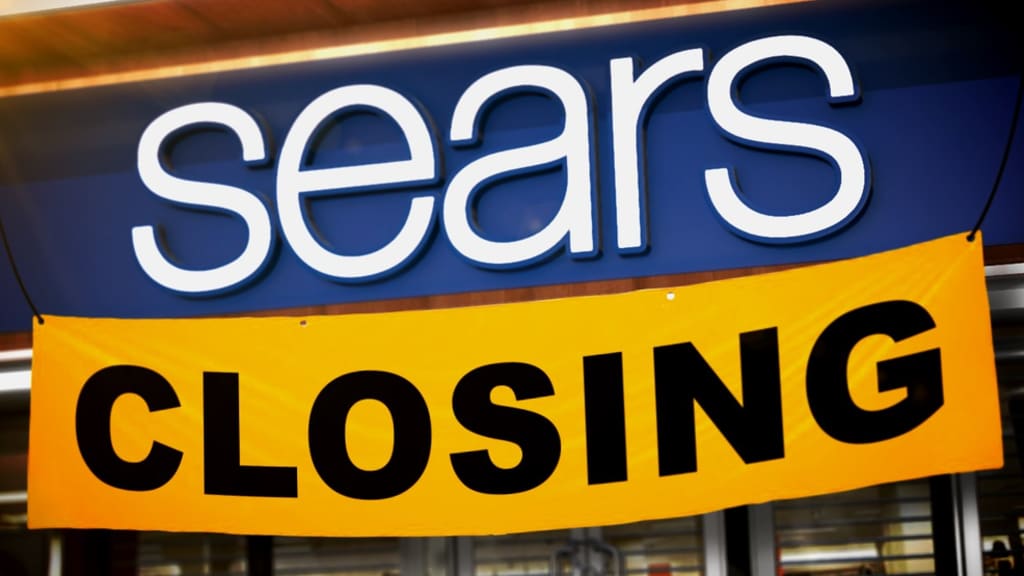
Sears is now a penny stock! Just let that sink in for a minute (and really, really sorry if you are unlucky enough to actually be a Sears stockholder!). This not only means that the companies stock has fallen to an all-time low, but that it could soon be delisted from the NASDAQ—making it harder to trade Sears Holdings stock for those who may actually want—or are brave enough—to do so!
The Sad, Downward Slide of Sears to Penny Stock Status

Five Year Performance of Sears Holdings Corporation (SHLD)
The once omnipresent store that was synonymous first for its gigantic catalog and later for being an anchor store in almost every mall in America is now literally itself in the bargain bin! The retailer has had a glorious run—but that run appears to be over! And the fate of Sears is just another sign of a seismic shift not just in retail—and real estate—in America, but the way that Americans will be shopping—and living—in the future.
We are now seeing the long, death march of Sears. How important has Sears been as a central part of American retail—and society—for decades? Take a look at this iconic scene from 1995's, The Brady Bunch Movie.
As America changed over most of the past century, Sears did change with it. At the beginning of the 20th Century, as America grew from a rural economy to one that was city-based, the Sears catalog was a source of (almost) everything under the sun! As the American population in the post-World War II environment began to expand from cities into suburban sprawl, Sears was there as malls began to take-over the retail landscape. The company enjoyed a long period of steady growth - capitalizing on its locations where people lived, having brands people recognized and held in esteem (i.e. Craftsman tools, Kenmore appliances, DieHard batteries - yes, before the Bruce Willis movies!). At one point, hard as this may be to believe today, Sears was not just a combination of what WalMart and Amazon are today, leading both in-store and out-of-store retailing, but the company was the largest employer in the United States!
And yet, in this stability of the 1960s-70s-80s and into the 1990s, Sears began to sow the seeds of its own destruction. It got fat. It got lazy. It got outflanked. Sears' top management focused on maximizing the sales and revenue from its many brick-and-mortar stores, rather than truly continuing to innovate. While Sears sat pat, a once little Arkansas outfit named Wal-Mart was expanding rapidly across the country and moving from simple stores to extra-large, 'Murica-sized stores with everything from tires to TV's to steaks. At the same time, Sears became regarded as "stodgy"—while it offered a full line of apparel and jewelry, the word "Sears" and fashion would never be uttered or written in the same sentence. In short, the chain was everywhere—trying to be everything to everybody, but it was actually going nowhere. And, with no notice or fanfare, a young Jeff Bezos drove across the country to Seattle to pursue his dream of selling books—and then a whole lot more—over the Internet, which would lead to an online revolution in retailing to which Sears was seemingly unprepared to respond to effectively.
Then, in 2004, Sears management made the decision to combine with Kmart to form Sears Holdings. While most corporate mergers make some degree of "sense," even more than a decade ago, this action was seen as one giant retailer on the decline simply combining with another failing retailer! Both companies had lots of locations, and on paper, the combination might, might at one point have made some sense to make the combined company a viable competitor to the ascending Wal-Mart. However, the execution was poor, the possible synergies never materialized, the supply chain issues persisted, the customer service problems only worsened, and the financial problems accelerated, meaning the "death spiral" for both retailers was well in process.
Sears itself was a "big box" store caught in a box. It was outflanked on every side and in every market in which it had once been a destination, if not dominant in, by new competitors, and its management made misstep after misstep in managing the chain, especially under the helm of current CEO and largest shareholder Eddie Lampert.
And now, approaching the end of 2018, Eddie Lampert—the former hedge fund manager who has tried to extend the life of Sears by extracting every ounce of leverage from its real estate holdings and what cash does remain, has proposed yet another plan to "save" the company. Lampert's plan number seven, eight, nine—who's really counting at this point—has been greeted mostly with yawns and observations that he is merely "rearranging the deck chairs on the Titanic"—just staving off his final chess move of admitting defeat, declaring bankruptcy, and closing the doors forever on what was once a proud chapter of American retail history.
And so, really at this point, the end of Sears—and Kmart as well—is a matter of when, rather than if. There may be small blips, small rays of hope, and yes, some actions—such as the partnership that is growing between Sears and Amazon—that could extend the life of Sears for a bit and provide a short-term boost to its stock. However, barring an all-time business miracle—or an outright purchase by Amazon of Sears assets, as some have indeed suggested, sometime in 2019, 2020, 2021 but likely no later than 2022, Sears—and Kmart as well—will both be gone.
And today, they're not the only big, impactful retailers who are on "death watch." In the department store game, JCPenney is on the ropes—and perhaps in as bad or even worse shape—which is really saying something! Pier One and Bed, Bath and Beyond are both reeling from devastating financial losses - and like Sears and JCPenney, fundamentally being unable to adapt with the times and the changing reality of retail today. As more and more shoppers turn to online options—read as primarily Amazon—first, they must find a real compelling reason to get off the sofa, fight the traffic, and actually go to a store to shop for almost anything in 2018. The stock performance of these companies says it all:
Sears: Sears Holdings Corporation (SHLD)

Five Year Performance of Sears Holdings Corporation (SHLD)
J. C. Penney Company Inc. (JCP)
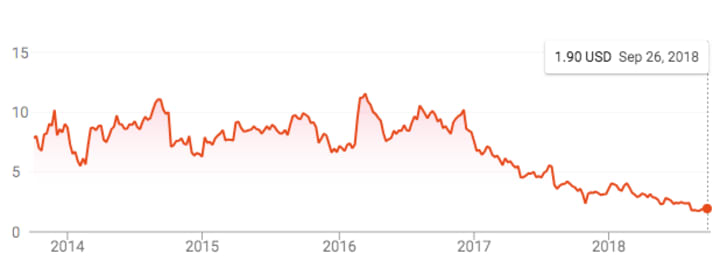
Five Year Performance of J. C. Penney Company Inc. (JCP)
Pier 1 Imports Inc. (PIR)
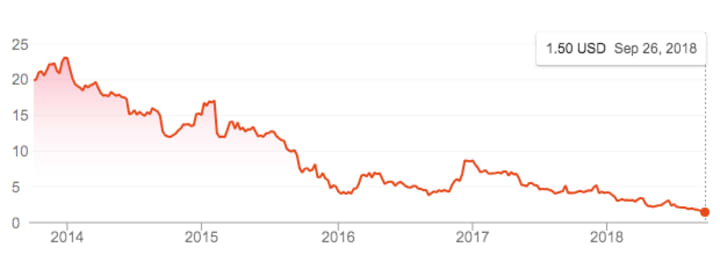
Five Year Performance of Pier 1 Imports Inc. (PIR)
Bed Bath & Beyond Inc. (BBBY)
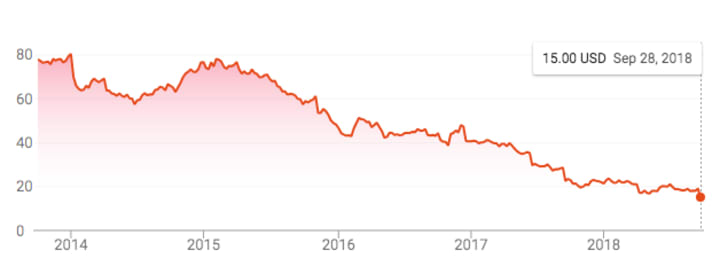
Five Year Performance of Bed Bath & Beyond Inc. (BBBY)
What do these four major American retailers that occupy thousands of locations and billions of retail square feet today have in common? Their value propositions are gone, vanished! Their marketing, their stores, their merchandise looks like yesterday, rather than whatever the future may hold. While some retailers have actually been fairly successful of late in competing in this increasing complex retail marketspace—namely TJMaxx and Marshalls' in the off-price segment, Macy's in the department store space, and Best Buy in electronics, Sears and the rest have not adapted to competing not just with in-store experiences, but with robust online offerings as well.
The dye has thus been cast for these pioneers of American retailing, as Sears Holdings (both Sears and Kmart), along with JCPenney, will likely continue to flounder in an endless cycle of sales declines, causing more store closings and cutbacks, causing more sales declines, and on, and on it goes. Firms that are in the "death spiral" simply do not have the ability internally to raise the cash or the external viability investors and lenders would need to make the necessary, radical changes necessary for a true turnaround. And if you lack not just investor confidence in your company, but the confidence of both your customers and your employees that their store will be there tomorrow... let alone next year, then it is truly "game over!"
In short, the academic analysis for Sears is likely very short and simple: Death! Death! Death! As legendary Berkshire Hathaway CEO Warren Buffett observed some years ago now, the maladies that affect American retailers have happened largely because they had executives that prioritized short-term goals over long-term success. The "Oracle of Omaha" stated: "If management makes bad decisions in order to hit short-term earnings targets, and consequently gets behind the eight-ball in terms of costs, customer satisfaction or brand strength, no amount of subsequent brilliance will overcome the damage has been inflicted." Sears, Kmart, JCPenney, Pier 1 Imports, Bed, Bath and Beyond—while the stories are somewhat different, their trajectories seem determined at this point - despite some contrarians out there who believe that traditional, "brick and mortar" stores can make a comeback.
So, looking ahead, what does the impending demise of not just Sears, but a number of other landmark chains with huge footprints across the American retail landscape mean for all of us? Certainly, each time we do see the final closing sales happen at these huge retailers, we face a number of important questions, not just from an economic perspective, but truly, from a societal one as well. That will be the focus of my next article on the subject for Journal.
About the Creator
David Wyld
Professor, Consultant, Doer. Founder/Publisher of The IDEA Publishing (http://www.theideapublishing.com/) & Modern Business Press (http://www.modernbusinesspress.com)


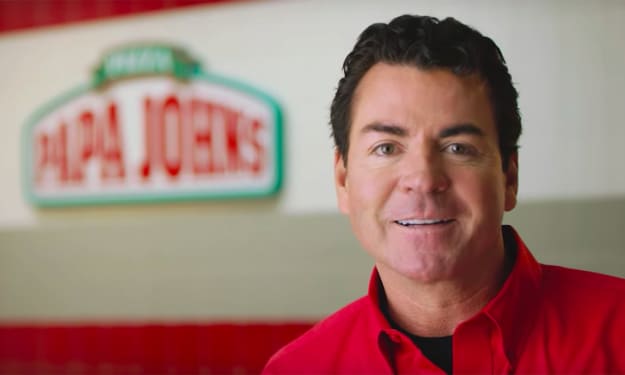



Comments
There are no comments for this story
Be the first to respond and start the conversation.